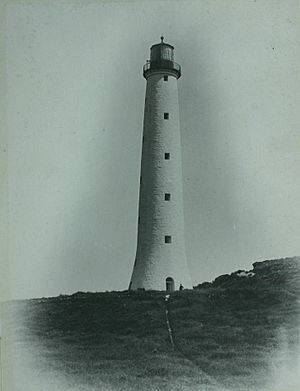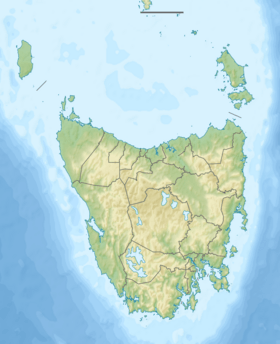Cape Wickham Lighthouse facts for kids
 |
|
| The lighthouse in 1887 | |
|
|
|
| Location | King Island Tasmania Australia |
|---|---|
| Coordinates | 39°35′18.7″S 143°56′34.7″E / 39.588528°S 143.942972°E |
| Year first constructed | 1861 |
| Automated | 1918 |
| Construction | stone tower |
| Tower shape | cylindrical tower with balcony and lantern |
| Markings / pattern | white tower and lantern |
| Height | 48 metres (157 ft) |
| Focal height | 85 metres (279 ft) |
| Intensity | 550,000 cd |
| Range | 24 nautical miles (44 km; 28 mi) |
| Characteristic | Fl W 10s. |
| Admiralty number | K2186 |
| NGA number | 6936 |
| ARLHS number | AUS-050 |
The Cape Wickham Lighthouse is a tall lighthouse on King Island in Tasmania, Australia. It stands 48 metres (157 ft) (about 157 feet) high, making it the tallest lighthouse in Australia! It's also recognized as an important historical site.
To reach the top of the lighthouse, you would need to climb eleven sets of wooden stairs. Each set has twenty steps. Around the lighthouse, you can still see parts of old buildings that were once used by the lighthouse keepers. There are also some gravestones, many of which belong to people who were shipwrecked in the area.
Contents
History of the Lighthouse
Why the Lighthouse Was Built
The Cape Wickham Lighthouse was built in 1861. It was put there because of a terrible shipwreck that happened sixteen years earlier. A ship called the Cataraqui sank nearby, and about 400 people lost their lives. The lighthouse was meant to warn ships about the dangerous coast.
Building and Early Challenges
When the lighthouse was being built, some people worried it might cause more shipwrecks. This was because most lighthouses showed a safe path, but this one was designed to warn of danger. Even so, the lighthouse was finished. However, shipwrecks still happened often until another lighthouse, the Currie Lighthouse, was built in 1879.
The Cape Wickham Lighthouse was made from local stone. A superintendent lived there and managed the light until it became automated in the 1920s. The superintendent sometimes had problems with hunters and other people living on the island. One report from 1873 said that some people tried to cause trouble for the superintendent. They would damage his property and try to make him leave.
Life at the Lighthouse
Lighthouse superintendents had to be very self-sufficient. This meant they had to be able to take care of themselves and their needs. A supply ship only visited the lighthouse once a year. Because of this, some lightkeepers had to find other ways to get supplies. One keeper was even dismissed from his job for keeping goods that his brother had found from a shipwreck.
Automation and Official Opening
In the 1920s, it was decided that people no longer needed to live at the lighthouse full-time. New systems were added to make the light work automatically. At this time, some of the buildings around the lighthouse, like the superintendent's house, were taken down. After that, the lighthouse keeper from nearby Currie looked after the Cape Wickham Lighthouse.
In 2011, during preparations for the lighthouse's 150th anniversary, people realized it had never been officially opened! To fix this, the Australian Governor-General, Quentin Bryce, held a special ceremony on November 5, 2011, to officially open the lighthouse.
Images for kids



